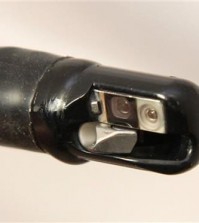- California Assembly OKs highest minimum wage in nation
- S. Korea unveils first graphic cigarette warnings
- US joins with South Korea, Japan in bid to deter North Korea
- LPGA golfer Chun In-gee finally back in action
- S. Korea won’t be top seed in final World Cup qualification round
- US men’s soccer misses 2nd straight Olympics
- US back on track in qualifying with 4-0 win over Guatemala
- High-intensity workout injuries spawn cottage industry
- CDC expands range of Zika mosquitoes into parts of Northeast
- Who knew? ‘The Walking Dead’ is helping families connect
Hospital or equipment makers to blame in ‘superbug’ scare?

This illustration released by the Centers for Disease Control depicts a 3-D computer-generated image of a group of carbapenem-resistant Enterobacteriaceae bacteria. The artistic recreation was based upon scanning electron micrographic imagery. A potentially deadly “superbug” resistant to antibiotics infected seven patients, including two who died, and more than 100 others were exposed at a Southern California hospital through contaminated medical instruments, UCLA reported Wednesday. (Melissa Brower/AP)
LOS ANGELES (AP) — With an antibiotic-resistant “superbug” outbreak connected to its facility, Ronald Reagan UCLA Medical Center stopped short of pointing a finger at the manufacturer of a medical instrument believed to have spread the deadly germs. The maker of the product was careful not to blame the hospital as it issued new cleaning instructions emphasizing meticulous manual sterilization.
Things may not be so polite once lawyers get involved.
Lawsuits are expected to follow the outbreak tied to two deaths and several infections, with the hospital and manufacturer pointing fingers at each other.
“That’s exactly the kind of skirmishing you’re going to see,” said John Culhane, co-director of the Family Health Law & Policy Institute at the Widener University School of Law in Delaware. “The bottom line is that the two defendants will be hauled into court, and they’ll be trying to do two things: One, they didn’t do anything wrong; the second thing is to pin the blame on the other defendant.”
Two people have died at UCLA, and five others have been infected with the bacteria known as carbapenem-resistant Enterobacteriaceae, or CRE, after undergoing similar endoscopic procedures to diagnose and treat pancreatic and bile-duct problems between October and January, hospital officials said. More than 170 other patients also may have been exposed.
The family of an 18-year-old student in grave condition from the bacteria is considering suing the endoscope’s manufacturer, Olympus Corporation of the Americas, an arm of Japan’s Olympus Corp, attorney Kevin Boyle said.
That hard-to-clean medical instrument used on more than half a million people in the U.S. every year has become the focus of the investigation into the outbreak.
Olympus emphasized in a statement Thursday that meticulous manual sterilization is needed. The company said it was issuing new instructions and working with federal officials.
The U.S. Food and Drug Administration warned doctors Thursday that the device’s complex design and tiny parts make complete disinfection extremely difficult. Even when cleaning instructions are followed, germs may linger, the FDA said. Between January 2013 and December 2014, the FDA received 75 reports involving 135 patients in the U.S. who may have been infected by tainted scopes.
The blame game has played out across the country where some patients are believed to have died from infections and hundreds of others have been shocked when notified they could have been infected with bacteria or a harmful disease from a medical instrument that was intended to help them.
In some cases, patients who weren’t infected have sued for having to go through the unnerving process of being screened over months for diseases such as HIV and hepatitis they may have been exposed to.
Pittsburgh medical malpractice lawyer Brendan Lupetin currently represents more than 200 patients in a class-action suit against a Pennsylvania clinic that he said didn’t properly clean its endoscopes. He envisions lots of lawsuits coming from the UCLA outbreak, with lawyers targeting both the hospital and Olympus and possibly third parties who may have been responsible for maintaining equipment used for cleaning and sterilization.
“It looks like someone dropped the ball,” Lupetin said. “Whether it’s the manufacturer or UCLA, you can almost guarantee there will be a number of lawsuits.”
However, Lawrence Muscarella, a health care and sterilization expert, said he doesn’t know of any lawsuits tied to outbreaks he’s closely followed at four other U.S. hospitals.
Few lawyers have taken on the hospitals because it can cost hundreds of thousands of dollars to prepare a case, and there’s no guarantee of success when it’s hard to prove what caused an infection, he said. Doctors rarely list the infection as the cause of death, and some hospitals have said patients entered their facility with the antibiotic-resistant bacteria, a notion he dismisses.
“Proving causation is impossible,” he said. “You can’t prove you didn’t have that organism when you came into the hospital.”
Culhane, the law professor, said that if cases do proceed to court, defendants probably won’t blame the victim for their role, as often happens in negligence cases. In these cases, the patient was probably unconscious.















